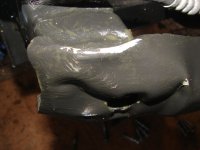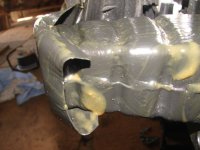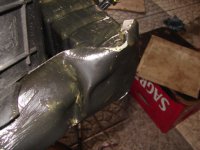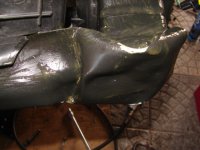A small amount of misalignment is inevitable, but they always pull left so it might be the same manufacturing issue that made the axles with a drooped spring pan.
Was it jrkitching said there are hardly any reports of rear tyre wear on the 500 section of this forum, whereas it's all too common on Pandas, and that perhaps the 500 rear axle is both better designed and manufactured? A 500 axle is getting rather tempting...
I would be surprised if any Pandas of this age had any true wheels
just noticed you are running the recommended 26psi at the rear. Depending on the tyre manufactures side wall construction. If you are spirited on roundabouts it could be tucking under slightly. I run 30 psi at the rear although its makes it a bit harsh.
Err, yes, I'm afraid I'm guilty of spirited driving on almost all twisty bits. As a result the outside shoulders of my front tyres take a hammering:
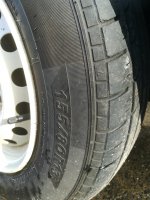
I feel my rears are wearing the outside tread, but it's not the shoulders, it's across the tread width if that make sense?

The tread depth at the grooves reduces from about 5mm inside, 3-4mm centre to 2mm outside on my rears, but is pretty uniform at 4mm across all grooves on my fronts (despite my suffering outer shoulders). Still, raising the pressure a bit on the rear sounds like a good idea, I do this with a heavy load anyway.
I can see that you are "infected" with the same pursuit of perfection that also plagues a number of us on here.
Are you sure you're retired, Jock? Sound pretty busy to me

It's more the case that I would be seething at shelling out £40-50 every two years for a new tyre, but 'pursuit of perfection' sounds much better, I'll claim that from now on!
I do believe, however, in doing a job once and doing it right. Again, mostly because it means less effort and expense in the long run. Soon we'll all have Pandas better than when they left the factory at this rate!

No there was no checking of suspension, steering connections or wheels before the alignment check, so as koalar, Jock and portland_bill say, a laser 4 wheel alignment carried out this way doesn't necessarily give accurate results either.
Your analysis of too much toe-in causing the pull to the left makes sense to me, although I understand a small amount of toe-in should aid straight-line stability. With marginal toe-out on my near side rear it does seem like the pull to the left has gone. (Still not met any dual carriageway yet though).
So in the interests of science, and unless I find any better advice, I think I should persevere with my proposed taking 0.1mm shim off N/S, adding 0.1mm to O/S, get tracking checked again to see if it shows within tolerance, and see if the left pull really has disappeared. It might not be for a little while, in the meantime, any insight or advice would be very welcome.




